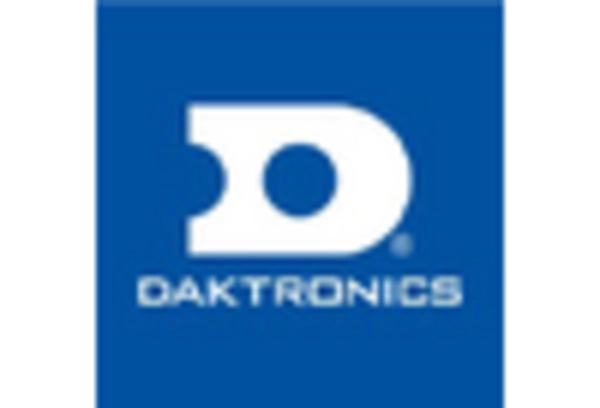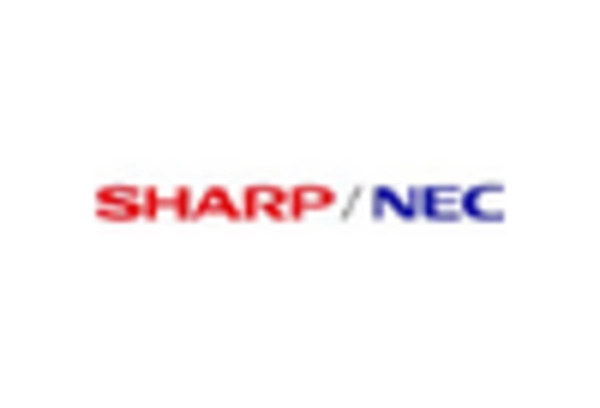Enhanced Advertising Opportunities
The LED Stadium Screens Market is witnessing a surge in demand due to enhanced advertising opportunities presented by LED technology. Advertisers are increasingly recognizing the value of high-visibility displays in stadiums, where large audiences gather for events. The ability to showcase dynamic and engaging advertisements on LED screens allows brands to capture the attention of fans effectively. Recent market analysis suggests that advertising revenue generated from LED displays in sports venues has increased by approximately 25% in recent years, highlighting the lucrative potential of these screens. As more companies seek to leverage the captive audience at live events, the demand for LED stadium screens is likely to grow. This trend indicates that the LED Stadium Screens Market is not only driven by technological advancements but also by the evolving landscape of sports marketing and advertising strategies.
Growing Popularity of Live Sports Events
The LED Stadium Screens Market is experiencing growth due to the increasing popularity of live sports events. As more fans seek to attend games in person, stadiums are investing in advanced LED screens to enhance the overall experience. The ability to display real-time statistics, instant replays, and engaging advertisements on large screens has become a crucial aspect of live events. Recent statistics suggest that attendance at major sports events has risen by approximately 20% over the past few years, indicating a robust demand for enhanced viewing experiences. This surge in attendance is likely to drive the need for high-quality LED screens, as venues strive to provide fans with an unforgettable experience. Consequently, the LED Stadium Screens Market is poised for growth as more venues recognize the value of investing in advanced display technologies to cater to the evolving preferences of sports enthusiasts.
Sustainability and Energy Efficiency Trends
The LED Stadium Screens Market is increasingly influenced by sustainability and energy efficiency trends. As environmental concerns gain prominence, stadiums are seeking to reduce their carbon footprint by adopting energy-efficient technologies. LED screens are inherently more energy-efficient compared to traditional display technologies, making them an attractive option for venues aiming to promote sustainability. Recent data indicates that the adoption of LED technology in sports venues can lead to energy savings of up to 50%, which is a compelling factor for many organizations. Furthermore, the integration of solar power solutions with LED screens is becoming more common, further enhancing their sustainability profile. This shift towards eco-friendly practices is likely to drive demand for LED stadium screens, as venues strive to align with global sustainability goals while providing high-quality visual experiences. The LED Stadium Screens Market is thus positioned to benefit from this growing trend.
Increased Investment in Sports Infrastructure
The LED Stadium Screens Market is benefiting from increased investment in sports infrastructure across various regions. Governments and private entities are allocating substantial funds to upgrade existing facilities and build new stadiums, which often include state-of-the-art LED screens as a key feature. This trend is particularly evident in emerging markets, where the construction of new sports complexes is on the rise. For example, recent reports indicate that investments in sports infrastructure have surged by over 15% in certain regions, reflecting a growing recognition of the importance of modern amenities in attracting events and audiences. As a result, the demand for LED stadium screens is likely to increase, as these screens are integral to enhancing the spectator experience and providing high-quality visual content during events. This investment trend is expected to significantly impact the LED Stadium Screens Market.
Technological Advancements in LED Stadium Screens
The LED Stadium Screens Market is experiencing rapid technological advancements that enhance the quality and functionality of stadium screens. Innovations such as higher resolution displays, improved brightness, and energy-efficient technologies are becoming increasingly prevalent. For instance, the introduction of 4K and 8K resolution screens is transforming the viewing experience for fans, making it more immersive. Additionally, advancements in software for content management and real-time data integration are allowing for more dynamic and engaging displays. According to recent data, the market for LED screens is projected to grow at a compound annual growth rate of approximately 10% over the next five years, driven by these technological improvements. This trend indicates a strong demand for high-quality visual experiences in sports venues, thereby propelling the LED Stadium Screens Market forward.

















Leave a Comment